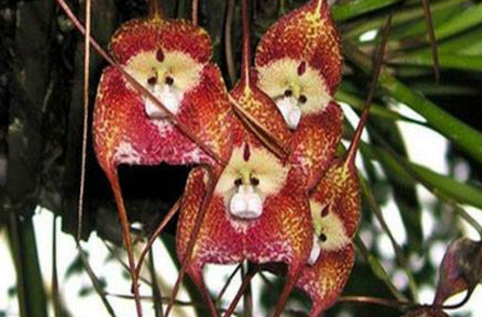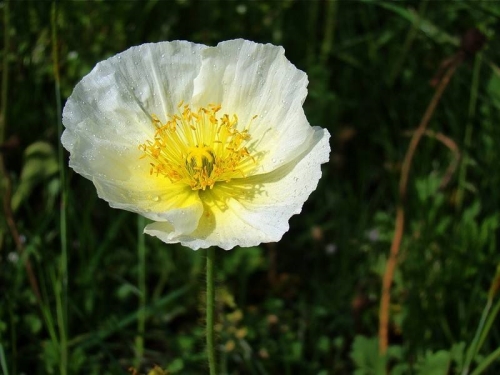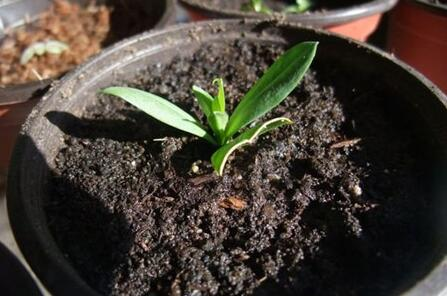The Propagation method of Monkey-faced Cymbidium
Sowing and reproduction
Monkey-faced cymbidium can self-pollinate, but the seeds are easy to scatter, so they should be collected in time. Monkey face small dragon orchid seeds, can be used to raise seedlings on a flat plate, do not need to cover the soil, to have sufficient sunshine, generally a month to seedling. Seedlings do not need to be often watered, keep the substrate moist, when the seedling height of more than 10 cm can be cultivated in flowerpots, but do not overwater.

Ramet propagation
Generally, ramets are carried out during the germination of new buds in early spring, first take out the mother plant, separate the knotted root system as far as possible, and plane it from the base with a knife. Each new plant should have a certain root system, and carbendazim powder can also be applied to the wound to avoid infection.
How to breed Monkey-faced Little Dragon Orchid
Monkey-faced cymbidium grows mainly in the foggy forests of southeastern Ecuador and Peru and is cultivated. It is vividly called "monkey-faced orchid" because of its monkey face. The flower can bloom in any season and gives off a smell similar to that of ripe oranges. There are two strange features, namely, two long thorns and two long calyx. So how to raise monkey-faced small dragon orchids? Next, let's introduce the breeding method of monkey face Xiaolan!
The growth habits of Monkey-faced Cymbidium
Monkey-faced small dragon orchid requires a cool growth environment, afraid of extreme heat, difficult to spend the summer, and is not resistant to frost and cold. 10-25 ℃ is the suitable cultivation temperature. The warmer areas in the south can be placed in outdoor semi-shade or cultivated in plastic greenhouses throughout the year. The Yangtze River valley or the north should be cultivated in greenhouses with medium or high temperatures. In late autumn, winter and early spring, the temperature is not very high. Direct sunlight is given to facilitate the plant to form flower buds, blossom and bear fruit. If you encounter high temperature weather or in summer, you should increase the humidity and cover the sunshade net to cool down. The temperature below 10 ℃ should be kept warm and heated.
The Propagation method of Monkey-faced Cymbidium
1. Ramet: the ramet of Monkey face is generally carried out before the new buds germinate in early spring, first take out the mother plant from the flowerpot, remove the excess matrix, separate the knotted root system as far as possible, and cut it open from the base of the stem with a sharp knife. Each new plant should keep two or more plants, with a certain root system, and use a brush dipped in sulfur powder or carbendazim powder to smear the wound to prevent the wound from infecting bacteria. After ramet, the new plant can blossom in the same year.
2. Sowing: monkey-faced Magnolia can self-pollinate, but the seeds are easy to scatter and should be harvested in batches at the right time. Because the seeds of monkey face orchid are small, they are usually sown in autumn in greenhouse, and the seedlings are raised with flat or hole trays, and the seeds do not need to be covered with soil. They should be fully exposed to light after sowing, and the seedlings will generally emerge in about 25 days. Do not water too frequently at the seedling stage, just keep the substrate moist. At the same time, fungicides were sprayed once a week, 2-3 true leaves should be transplanted once, and planted in flowerpots when the seedling height was more than 10 cm, and the seeded seedlings could blossom for 1-2 years.
The culture method of monkey face small dragon orchid
1. Matrix: monkey face small dragon orchid prefers acidic matrix, which requires loose air permeability and good drainage, which can keep the root moist without stagnant water. Generally, the substrate can be used for orchid cultivation. When the seedlings are installed in a basin, first put a coarse-grained matrix or ceramsite with a thickness of 2cm in thickness at the bottom of the basin as a filter layer, sprinkle some Ordovician granule controlled-release fertilizer as base fertilizer, apply 2g in each pot, and cover a substrate about 1cm in thickness, then put in the plant to separate the fertilizer from the root system and avoid root burning.
2. Moisture: the original environment of monkey face is relatively dry, and it is easy to be infected by bacteria if it is too long in cloudy and rainy days. Therefore, the relative humidity should be kept between 50 and 75% during the growing period. When the temperature is about 20 ℃, you can keep the natural environment indoors. When the summer temperature is more than 25 ℃, artificial humidification is carried out, generally using fan and water curtain or high-pressure spray system, but avoid spraying water on the leaf surface. There should be more ventilation when the humidity is too high, otherwise diseases and insect pests are easy to occur. The moisture needed by monkey face orchid generally depends on the substrate used. If water plants are used, water should be watered less, and when the substrate is 70% dry, water should be watered in time.
3. Fertilizer: monkey-faced Magnolia needs less fertilizer, and its general fertilizer concentration is 3000 times of liquid. It should be fertilized every two weeks in the growing season from May to October. Liquid fertilizer should be used to irrigate the root zone and spray the leaf surface. The growing period of monkey face orchid is mainly nitrogen fertilizer and balanced fertilizer, often using N:P:K=30:10:10 or 20:20:20 mixed fertilizer. The mixed fertilizer of N:P:K=10:30:10 is commonly used during flowering. It is best to apply fertilizer in the evening and water again in the early morning. At the same time, in the flower bud stage, special orchid flowering fertilizer, Huabao 3, potassium dihydrogen phosphate and other phosphorus and potassium fertilizer were sprayed once a week to make the arrows stronger and the flowers bright.
The breeding method of Monkey face Little Dragon Orchid how to reproduce
In addition to the monkey face, the monkey-faced dragon orchid has two strange features, namely, two long thorns and two long calyx. Its unique appearance has brought it a lot of popularity. I would like to share with you the breeding method of monkey-faced small dragon orchid. How does monkey-faced small dragon orchid breed? Let's take a look.
The Propagation method of Monkey-faced Cymbidium
The seedling propagation of monkey face small dragon orchid can be propagated by means of ramet, sowing, aseptic sowing, tissue culture and so on.
Ramet propagation
Monkey face small dragon orchid belongs to perennial epiphytic orchid, planted for 1-2 years, when the plants are dense, it can be propagated separately. Ramets are generally carried out before the germination of new buds in early spring, first take out the mother plant from the flowerpot, remove the excess matrix, separate the knotted root system as far as possible, and cut open from the base of the stem with a sharp knife, each new plant should keep two or more plants with certain roots, and use a brush dipped in sulfur powder or carbendazim powder to smear the wound to prevent the wound from infecting bacteria. After ramet, the new plant can blossom in the same year. [3]
Sowing and reproduction
Monkey noodles can be self-pollinated, but the seeds are easy to scatter and should be harvested in batches at the right time. Because the seeds of monkey face orchid are small, they are usually sown in autumn in greenhouse, and the seedlings are raised with flat or hole trays, and the seeds do not need to be covered with soil. They should be fully exposed to light after sowing, and the seedlings will generally emerge in about 25 days. Do not water too frequently at the seedling stage, just keep the substrate moist. At the same time, fungicides were sprayed once a week, 2-3 true leaves should be transplanted once, and planted in flowerpots when the seedling height was above 10cm. The seeded seedlings can blossom for 1-2 years. The resistance of seedlings is poor, once too much water, it is easy to get sick and cause stem and root rot.
Aseptic sowing
The effect of aseptic sowing before the capsule is about to mature is the best. The sowing medium may be 1gram 2ms milk 10% coconut juice or banana juice 50g Uniql + lactoprotein 2g Uniql + sucrose 20-30g Unix L + Agar 8g/L. Light green swollen embryos can be seen at 15 days after sowing. When protocorms about 2mm in diameter are formed at 50ml 60 days, they can be transferred to MS+BA1mg/L medium and grow into seedlings with 2LV and 3 leaves after 60th day. Then transferred to the rooting medium, about 60 days to grow into a complete plant out of the bottle cultivation. When the test-tube plantlets came out of the bottle, they were planted in the mixed matrix of sterilized water moss or peat soil and perlite, and the survival rate was more than 85%. 3Mel can be planted in pot for 5 months and blossom in 1-2 years after planting. [3]
Tissue culture
The buds and shoot tips of the plants with strong growth were selected as explants. The induction medium is generally MS+6-BA1.0-2.0mg/L+IBA0.5-1.0mg / L + activated carbon 1.0-3.0g/L. Generally, the multiplication medium was MS+6-BA0.5-1.0mg/L+IBA0.1-0.5mg / L + activated carbon 1.0-3.0g/L. The differentiation medium is generally 1/2MS+6-BA1.0-1.5mg/L+NAA0.5-1.0mg/L. The medium for rooting and strengthening seedlings was 1/2MS+6-BA0.5-1.0mg/L+lBA0.1-0.5mg/L.
When the root length of the tissue culture seedling in the bottle is about 2-4cm, the culture bottle is placed in a greenhouse to refine the seedling. After 7 days, the rooting seedling is taken out, the medium is washed, and the culture medium is soaked in 0.1% potassium permanganate solution for 5 minutes. The planting substrate was a mixture of bark and peat at 1:1, soaked in water and disinfected with broad-spectrum fungicides, and the seedlings were planted in the seedling plate. When transplanting, the relative humidity is controlled at 50% Mel 70%, and the light intensity is not greater than 10000lx in the greenhouse or greenhouse. After transplanting, the fungicide was sprayed once, and the temperature was kept at 18 ℃-25 ℃. When the new root grew, it was managed routinely.
Monkey face small dragon orchid how to breed, after seeing the monkey face small dragon orchid breeding method that Xiaobian carefully arranged for everyone, we should all know how to breed, and your favorite friends should start planting as soon as possible.
- Prev

Planting techniques of seed bulbs of Ranunculus chinensis
In order to prolong the growth period, we can choose to sow in September and sow in October later. The optimum temperature for bulb germination is 10 to 15 degrees. In order to facilitate the management of the sowing box, buttercup bulbs are often sown in the sowing box.
- Next

Specific steps of Platycodon grandiflorum cutting
1. First insert a small hole in the basin soil with chopsticks or sticks, put the cuttings in, and then compact the basin soil with your hands and water it thoroughly. two。 Cover with a thin film or transparent lid and put a few small holes in it for ventilation. 3. Because Platycodon grandiflorum likes to live in places with strong light.
Related
- Fuxing push coffee new agricultural production and marketing class: lack of small-scale processing plants
- Jujube rice field leisure farm deep ploughing Yilan for five years to create a space for organic food and play
- Nongyu Farm-A trial of organic papaya for brave women with advanced technology
- Four points for attention in the prevention and control of diseases and insect pests of edible fungi
- How to add nutrient solution to Edible Fungi
- Is there any good way to control edible fungus mites?
- Open Inoculation Technology of Edible Fungi
- Is there any clever way to use fertilizer for edible fungus in winter?
- What agents are used to kill the pathogens of edible fungi in the mushroom shed?
- Rapid drying of Edible Fungi

